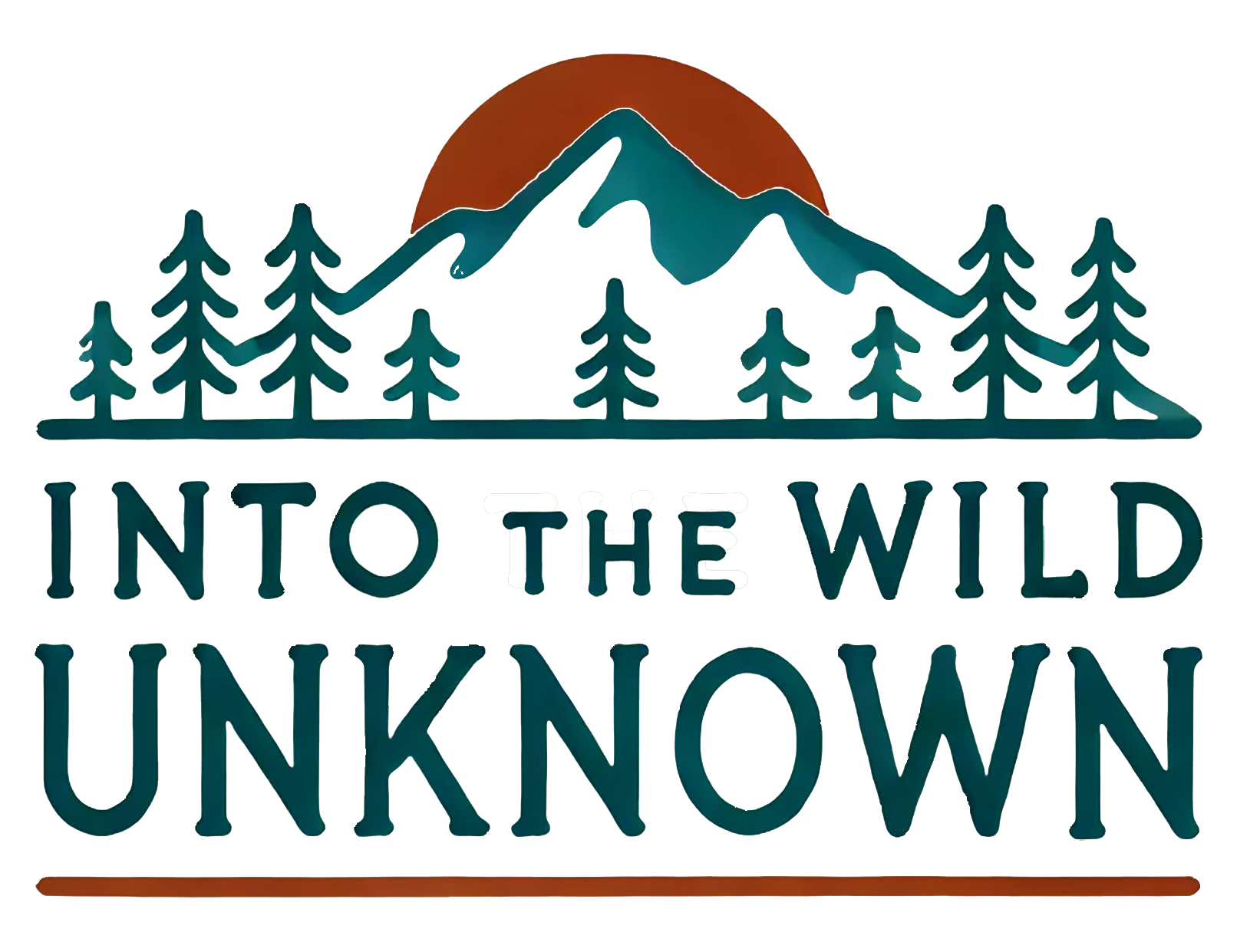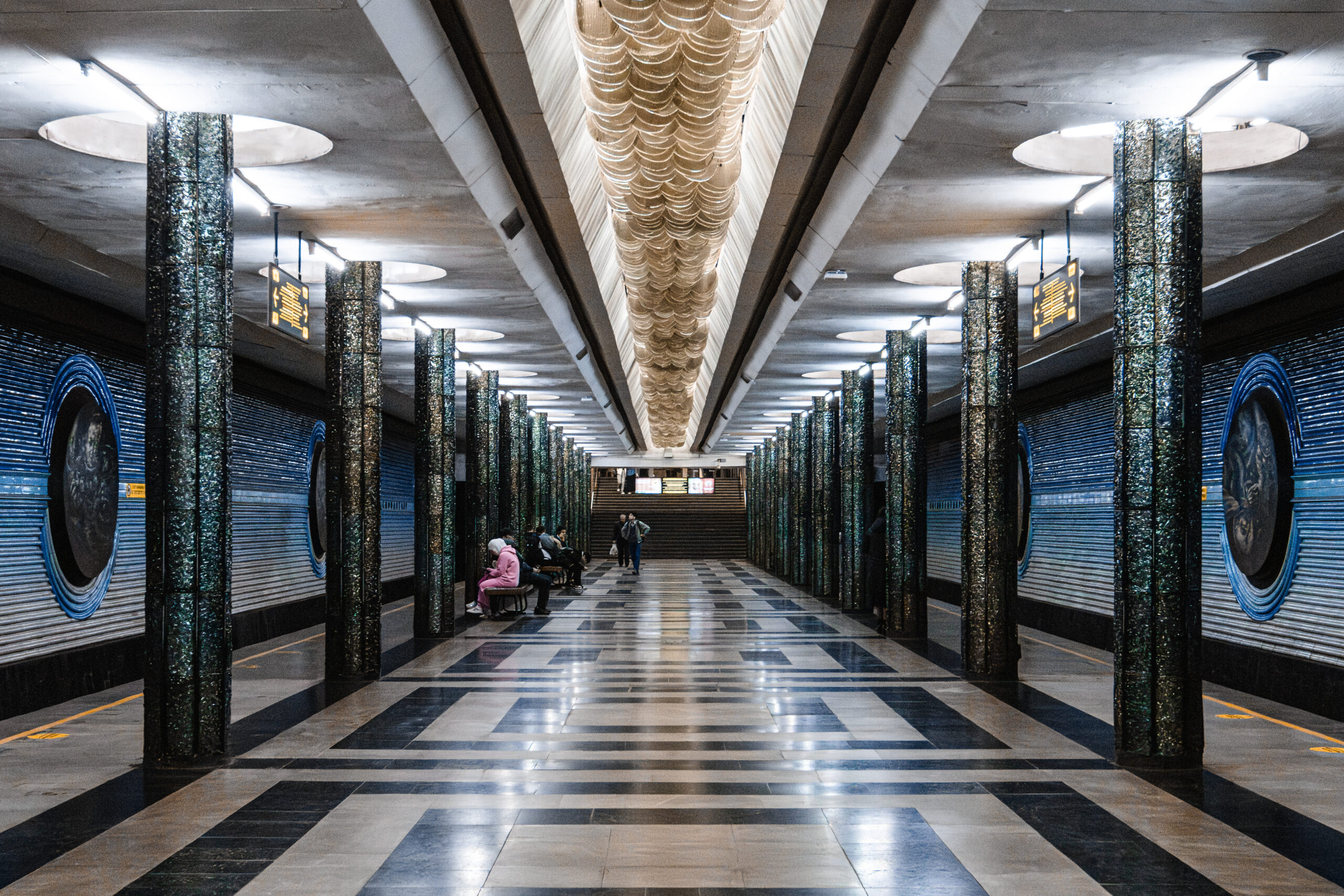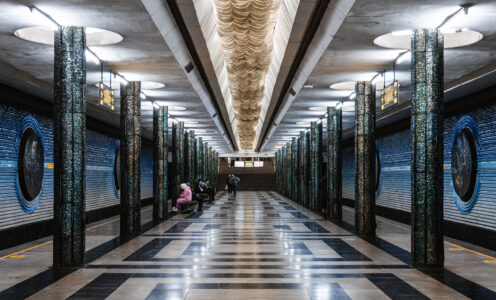Tashkent, the capital of Uzbekistan, is often overlooked by travellers rushing off to Samarkand or Bukhara, but this dynamic city deserves a spot on your itinerary. In this complete budget travel guide, you’ll find everything you need to know to explore Tashkent independently – including how to get around, what to see and do, and how to make the most of your stay without breaking the bank.
Uzbek’s capital city is a fascinating blend of Soviet-era architecture, leafy parks, vibrant bazaars, and a modern cosmopolitan vibe, and it offers a unique introduction to the country. It’s also the main international gateway to Uzbekistan, making it a convenient and budget-friendly place to start or end your Silk Road adventure.
From wandering through its colourful bazaars and sipping tea in leafy courtyards, to hopping on its ornate Soviet metro and discovering remnants of its ancient past, Tashkent is full of contrasts waiting to be explored.
How to Get to Tashkent
Most likely, your Uzbek adventure will begin in the capital city of Tashkent, either by flying into Tashkent International Airport – the country’s main international gateway – or by arriving overland from neighbouring countries. Many backpackers exploring Central Asia choose to arrive overland using public transport, a budget-friendly and flexible option.
From Kyrgyzstan, there are affordable buses and shared taxis connecting Bishkek to Tashkent. Another popular route is from Osh into the Fergana Valley, which takes you into eastern Uzbekistan. These crossings are straightforward and commonly used by travellers.
From Tajikistan, the most popular and convenient border crossing into Uzbekistan is between Dushanbe and Samarkand. This crossing is fully open to foreigners and easy to do independently. You can take a shared taxi from Dushanbe to the border, and then catch another shared taxi or bus on the Uzbek side to Samarkand or Tashkent.
Coming from Kazakhstan is even easier. You can take buses or, even better, hop on a direct train from Almaty or Shymkent to cities like Tashkent or Samarkand. Trains are more comfortable, scenic, and ideal for long journeys. Border procedures on international trains are very smooth. The train stops briefly at both the Kazakh and Uzbek border checkpoints, where border guards come on board, scan your passport, and stamp it – no need to leave the train. You can check and book tickets for these trains online through platforms like Uzbek Railways or Tutu, though ticket availability can vary depending on the route and season.
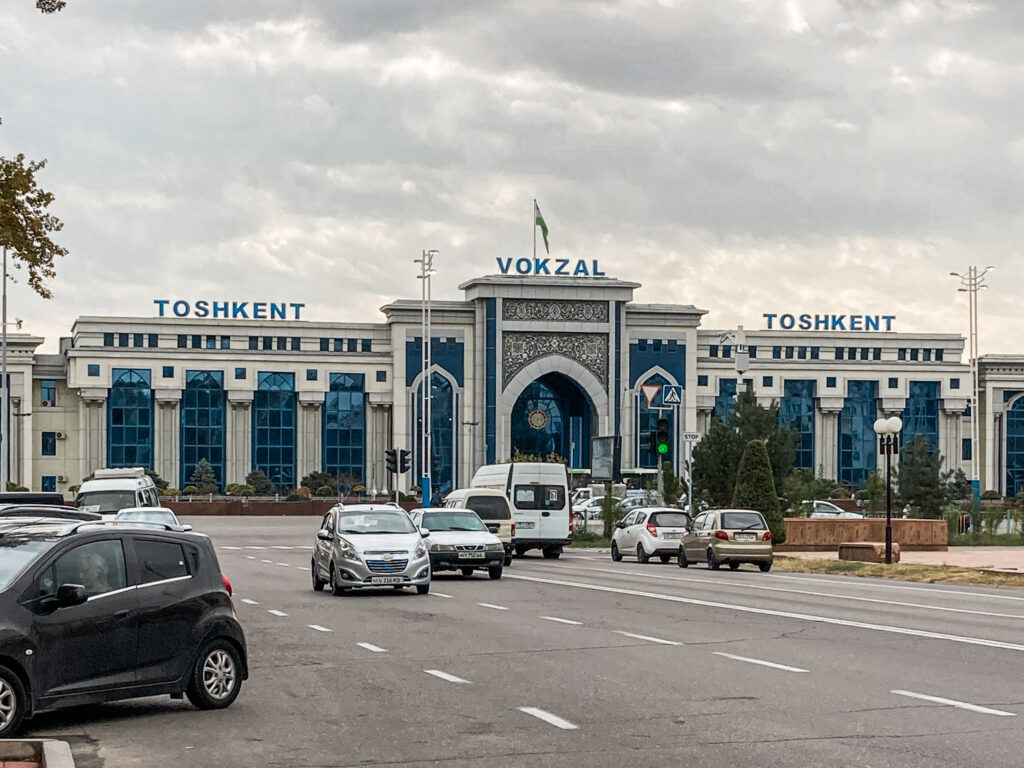
How to Get Around Tashkent
Tashkent is the most modern and well-connected city in Uzbekistan, and getting around is relatively easy and affordable. The Tashkent Metro is not only the most efficient way to move around the city, but also an attraction in itself since each station is uniquely designed with ornate Soviet-era architecture. A single metro ride costs around 2,000 UZS (around €0.20), and trains run frequently from early morning until late evening.
In addition to the metro, you can use Yandex Go (ride-hailing app similar to Uber) to call taxis anywhere in the city. It’s cheap, reliable, and eliminates the need to negotiate prices. Local marshrutkas (shared minibuses) and buses are also available and very budget-friendly, although they can be tricky to navigate. Use the 2GIS app to help you navigate the public transport system.
If you prefer walking, many central areas, such as Amir Timur Square, Broadway Street, and Independence Square, are pleasant to explore on foot, especially in spring or autumn when the weather is mild.
Top Things to Do in Tashkent
Visit the Hazrat Imam Complex
Home to the world’s oldest Quran, the Khast Imam Complex is Tashkent’s most important religious site. The beautiful blue-domed mosques and madrasas are a peaceful place to wander, and there’s no entrance fee to the complex itself. However, the museum housing the Quran has a small fee (around 25,000 UZS).
There are some beautiful architectural monuments, such as the Barak Khan Madrasah, the Tilla Sheikh Mosque and the mausoleum of Saint Abu Bakr Kaffal Shashi. They are a nice introduction to the impressive Islamic architecture that you’ll find later in the Silk Road cities.
Explore Tashkent’s Metro Stations
Don’t miss the chance to ride the Tashkent Metro, a Soviet masterpiece filled with chandeliers, mosaics, and marble columns. It’s not only a cheap way to get around but also one of the most unique metro systems in the world. Here’s a list of the more impressive metro stations:
Alisher Navoi
Opened in 1984, Alisher Navoi Metro Station in Tashkent stands as a tribute to the esteemed 15th-century poet and philosopher, Alisher Navoi. The station’s design harmoniously blends Soviet-era architecture with traditional Uzbek motifs, featuring intricate tile-work, marble columns, and colourful mosaics that depict scenes from Navoi’s literary works.
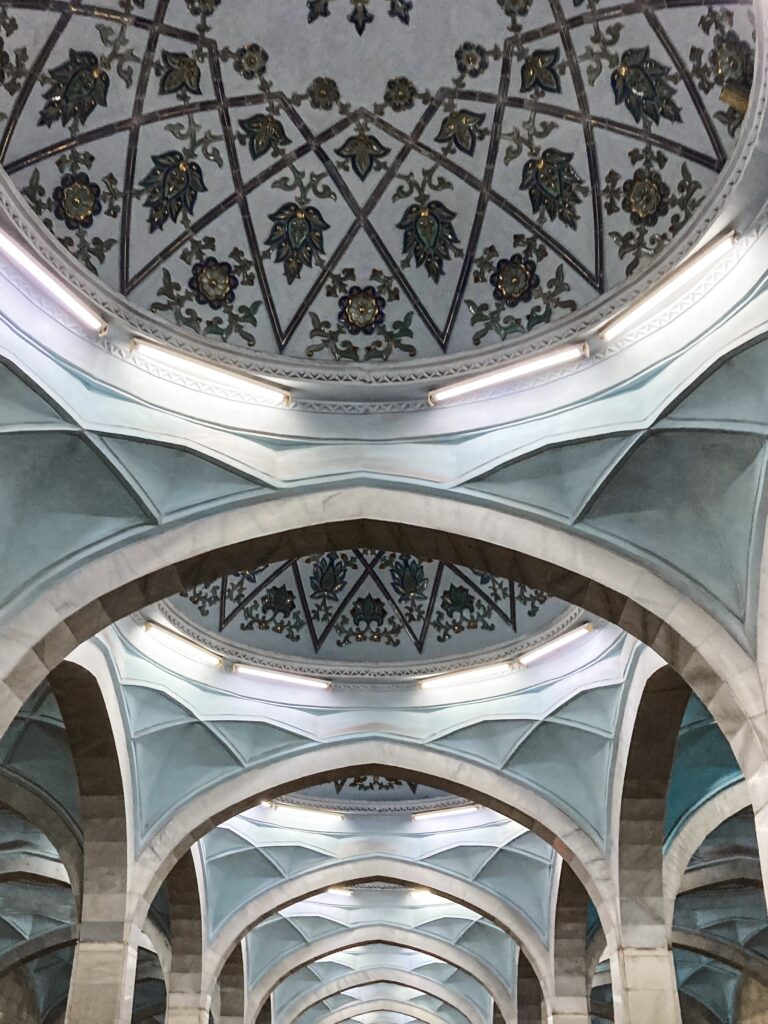 Alisher Navoi’s Ceiling
Alisher Navoi’s Ceiling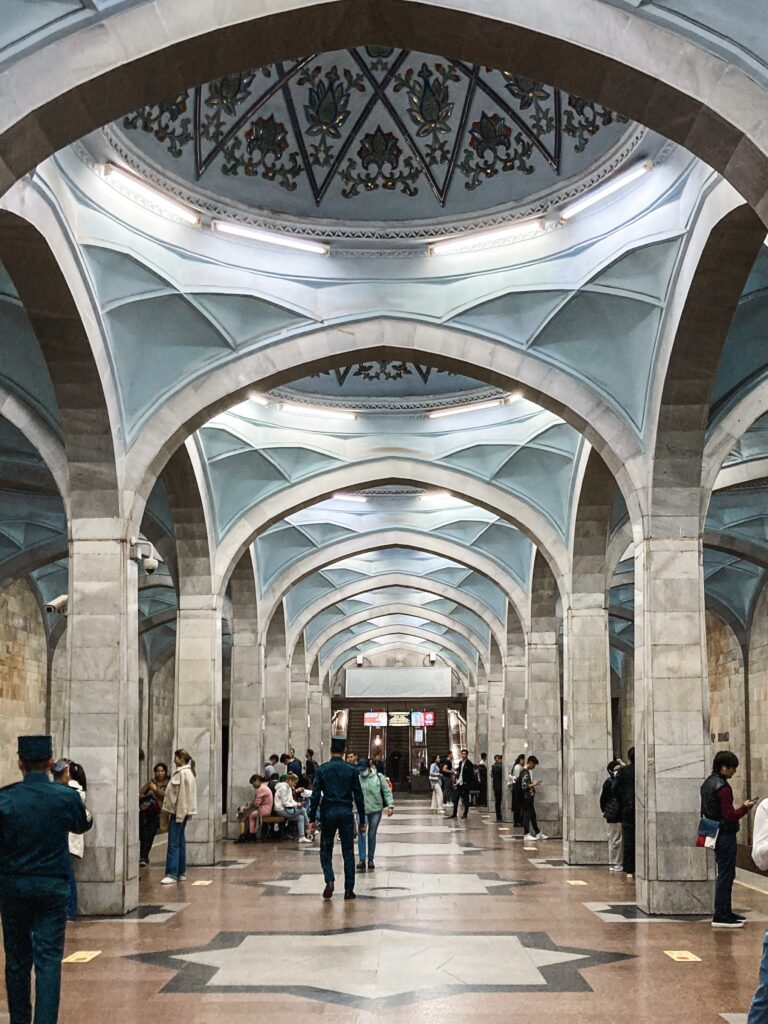 Alisher Navoi Metro Station
Alisher Navoi Metro Station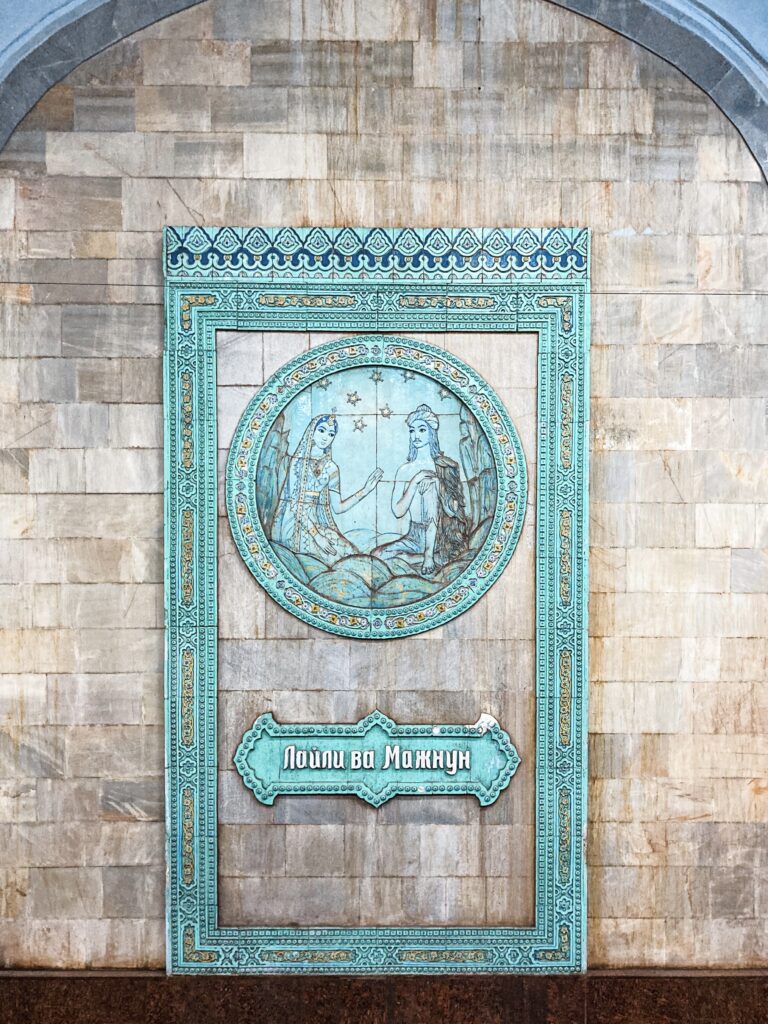 Alisher Navoi’s Details
Alisher Navoi’s Details
Tinchlik
Tinchlik Metro Station, inaugurated in1991, is a notable stop on Tashkent’s Oʻzbekiston Line. The platform area is adorned with marble columns topped with illuminating lamps, and crystal chandeliers hang from the ceiling, casting a warm glow throughout the space. Stained glass walls add a vibrant touch, creating a harmonious blend of light and colour.
Kosmonavtlar
Kosmonavtlar Metro Station, inaugurated in 1984, is one of Tashkent’s most distinctive and artistically significant subway stations. Dedicated to the achievements of Soviet cosmonauts, the station’s design immerses passengers in a cosmic ambiance. The walls feature large medallions honouring space pioneers like Yuri Gagarin and Valentina Tereshkova, set against a backdrop that evokes the vastness of the universe. Illuminated columns wrapped in glass contribute to a sense of weightlessness, enhancing the station’s space-themed aesthetic.
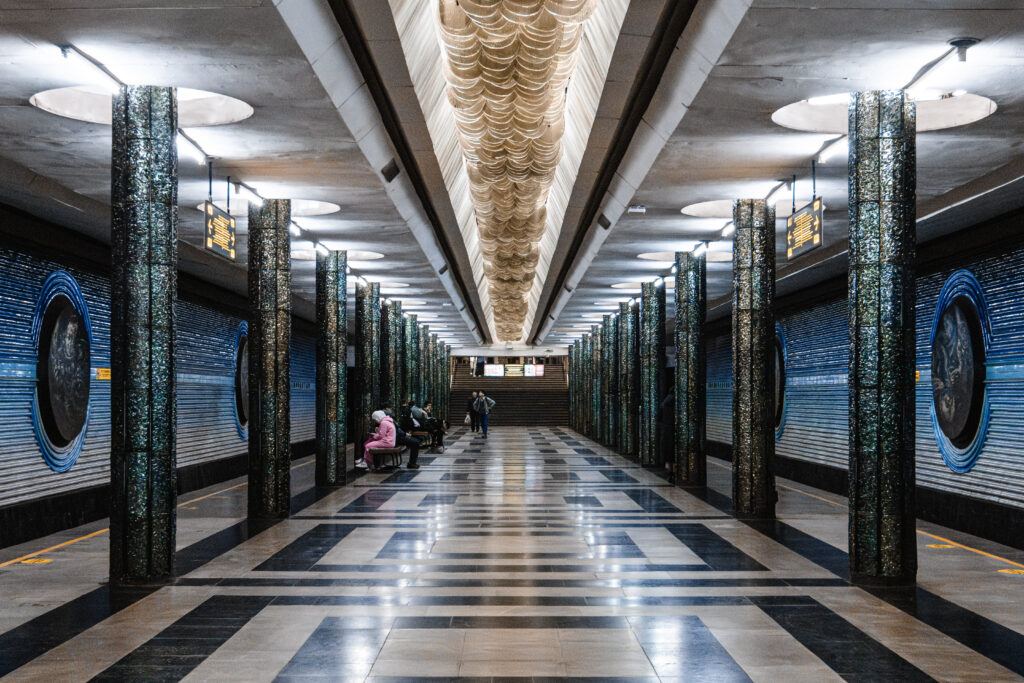 Kosmonavtlar Metro Station
Kosmonavtlar Metro Station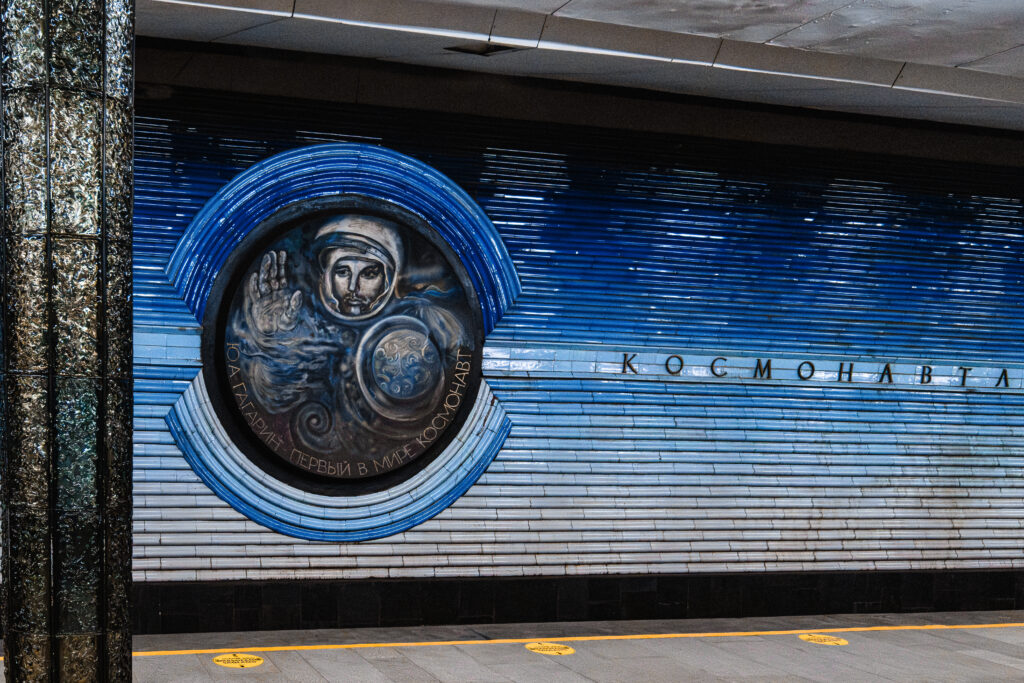 Kosmonavtlar Metro Station
Kosmonavtlar Metro Station
Gafur Gulom
Gafur Gulom Metro Station, located in Tashkent, Uzbekistan, is named in honour of the esteemed Uzbek poet and writer, Gafur Gulom, renowned for translating works by Pushkin, Mayakovski, and Shakespeare into Uzbek. The station is distinguished by its striking turquoise granite columns, which harmonise with the intricate mosaics adorning the walls, creating a visually captivating environment. This design reflects a blend of Soviet architectural style and traditional Uzbek artistic elements.
Mustaqillik Maydoni
Mustaqillik Maydoni Metro Station, located beneath Tashkent’s central Independence Square, is one of the most striking stops on the city’s Chilonzor Line. Originally named after Lenin during the Soviet era, it was renamed after Uzbekistan’s independence and now symbolises the country’s newfound sovereignty. The station’s design is grand and ceremonial, featuring marble from the Kyzylkum desert, high arches, elegant chandeliers, and glass columns that reflect a fusion of Soviet monumentalism and Uzbek aesthetics.
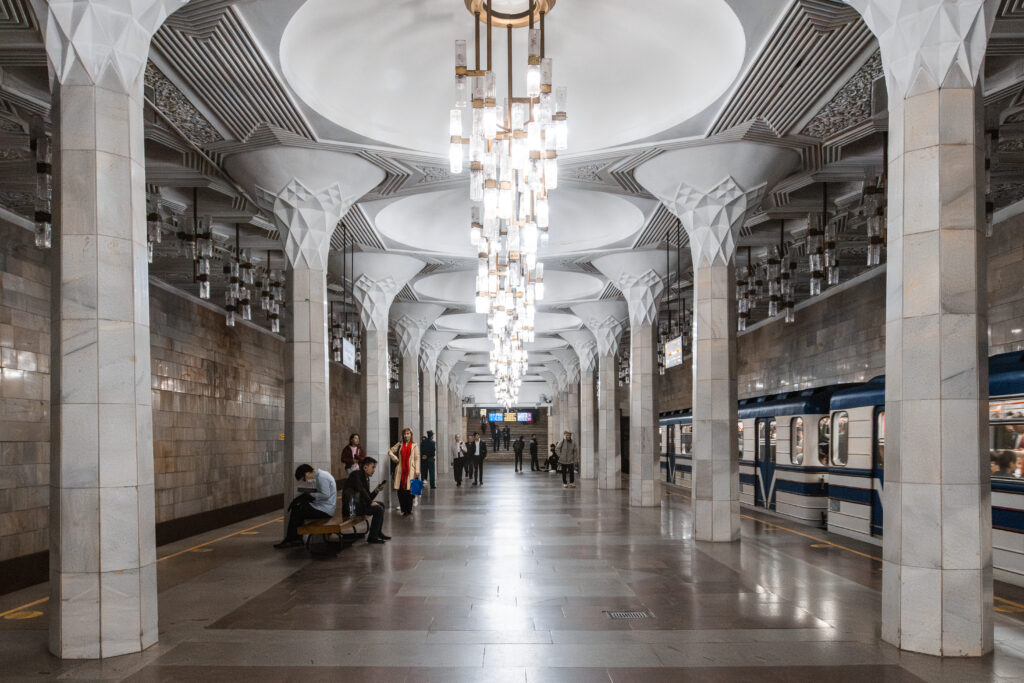 Mustaqillik Maydoni Metro Station
Mustaqillik Maydoni Metro Station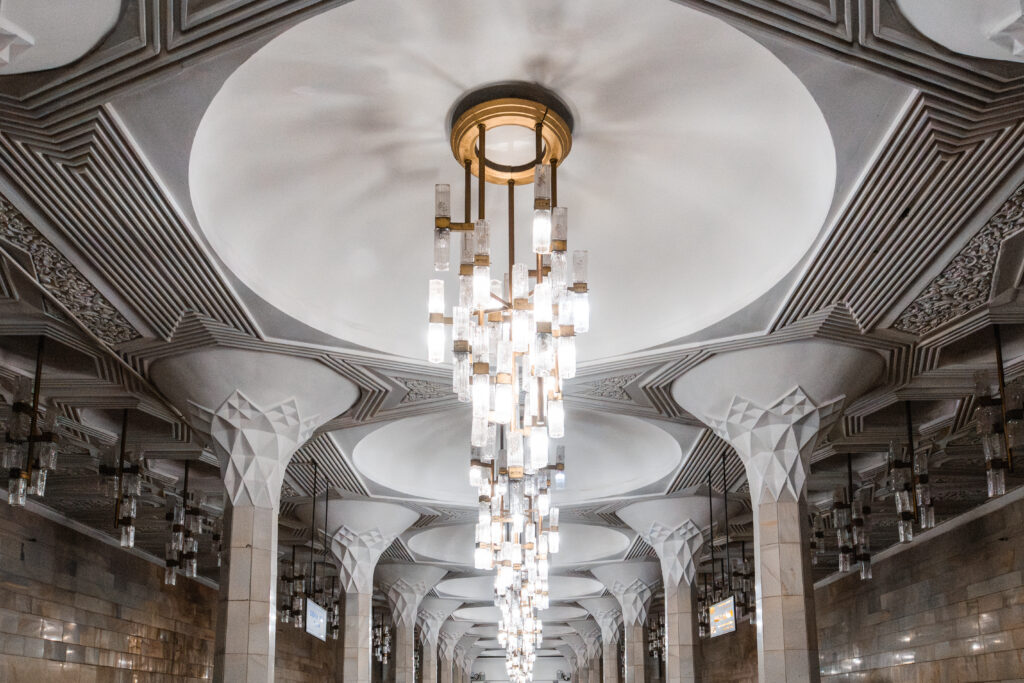 Mustaqillik Maydoni Metro Station
Mustaqillik Maydoni Metro Station
Paxtakor
Paxtakor Metro Station, opened in 1977, is a notable stop on Tashkent’s Chilonzor Line. Located near the Paxtakor Stadium, the station’s design reflects a blend of Soviet modernist architecture and Uzbek cultural motifs, featuring sleek lines and functional elements. Its interior is adorned with abstract mosaics that pay homage to Uzbekistan’s cotton industry, symbolising the nation’s agricultural heritage.
Beruniy
Beruniy Metro Station, inaugurated in1991, serves as the northwestern terminus of Tashkent’s Oʻzbekiston Line. The station’s design reflects Uzbekistan’s national traditions, featuring a dome adorned with intricate marble patterns and illuminated by crystal chandeliers.
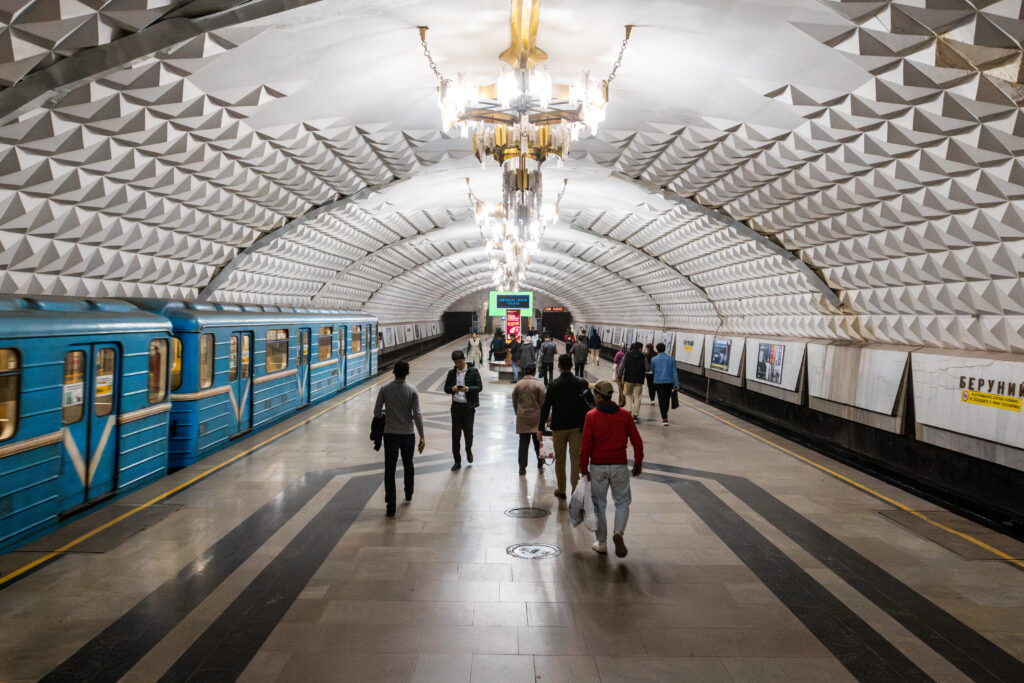
Chilonzor
Chilonzor Metro Station, inaugurated on November 6, 1977, serves as a significant stop on Tashkent’s Chilonzor Line. The station’s design features vibrant chandeliers and intricate mosaics, reflecting Uzbekistan’s rich cultural heritage.
Yunus Rajabiy
Yunus Rajabiy Metro Station, opened in 2001, is a notable stop on Tashkent’s Yunusobod Line. Dedicated to the esteemed Uzbek composer Yunus Rajabiy, the station’s design exemplifies Soviet architectural influences, featuring expansive marble surfaces, imposing columns, and grand metal chandeliers.
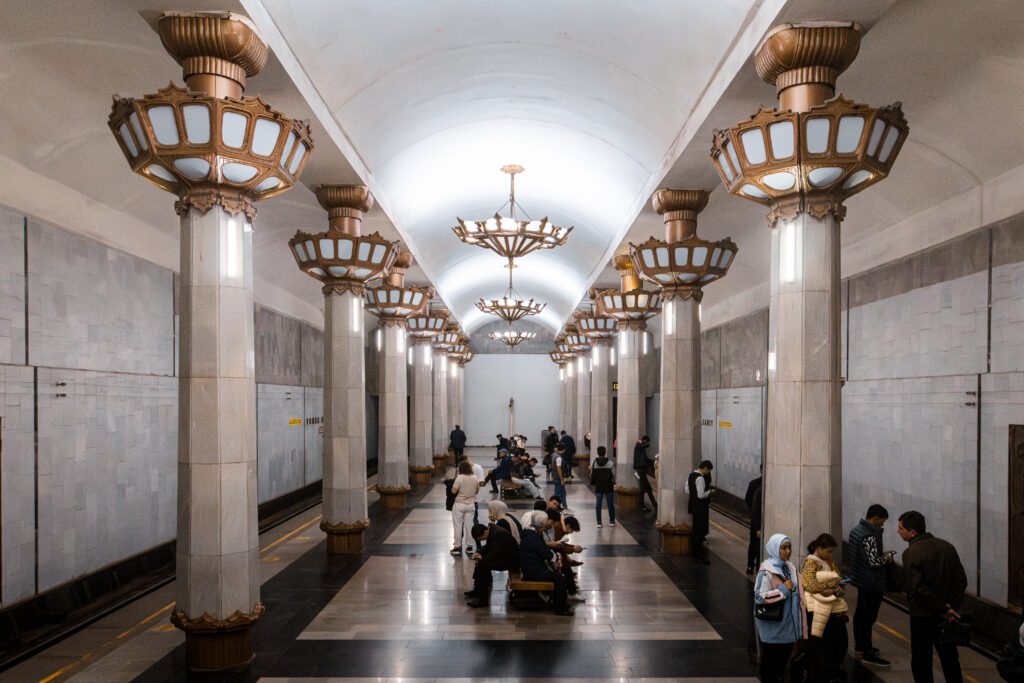
Toshkent
Tashkent Metro Station, located on the Oʻzbekiston Line, is one of the city’s key transit points. The station’s design features blue and white mosaics depicting scenes of Uzbek daily life and historical landmarks, offering passengers a glimpse into the nation’s cultural heritage.
Bodomzor
Bodomzor Metro Station, situated on Tashkent’s Yunusobod Line, was inaugurated in 2001. The station’s design features geometric patterns on the ceiling and modern lighting, creating a futuristic ambiance. This contemporary design contrasts with the more ornate styles of earlier stations, offering a unique visual experience.
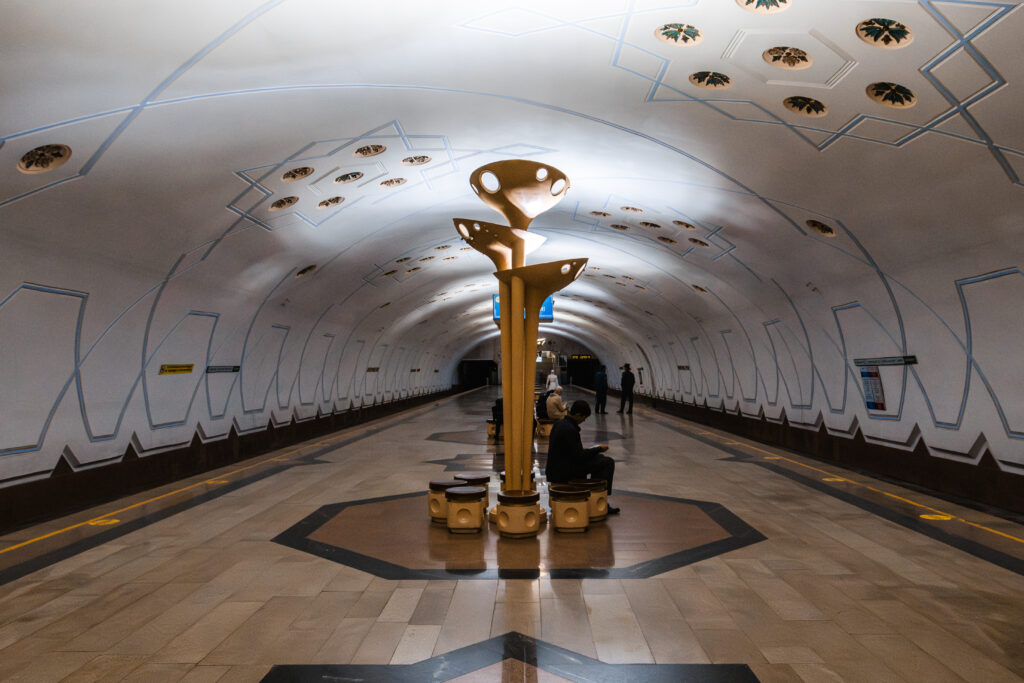 Bodomzor Metro Station
Bodomzor Metro Station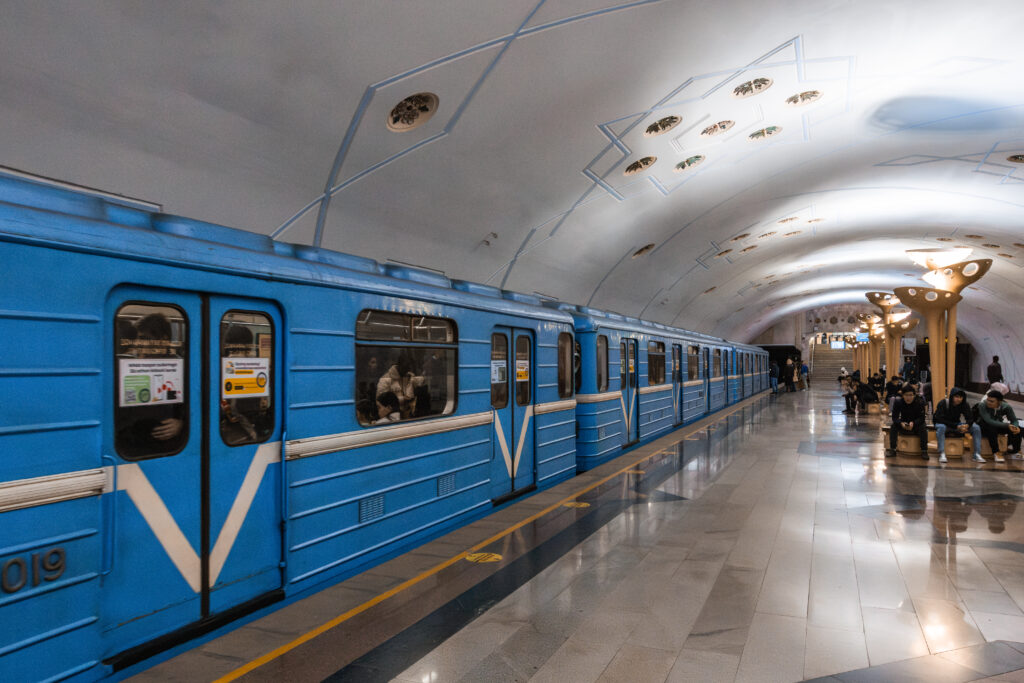 Bodomzor Metro Station
Bodomzor Metro Station
Wander Through Chorsu Bazaar
One of the first things I love to do when arriving in a new city is visiting the local market. You can learn so much about a country and its daily life just by wandering through a bazaar. And the colourful Chorsu Bazaar, at the chaotic heart of Tashkent’s old town, is no exception. Under its iconic dome, you’ll find everything from fresh produce, dried fruits to spices, nuts, and household goods. Seriously, you can find anything in here! It’s also a great place to grab a cheap, authentic bite, like freshly baked bread or a hearty serving of plov from a local food stall.
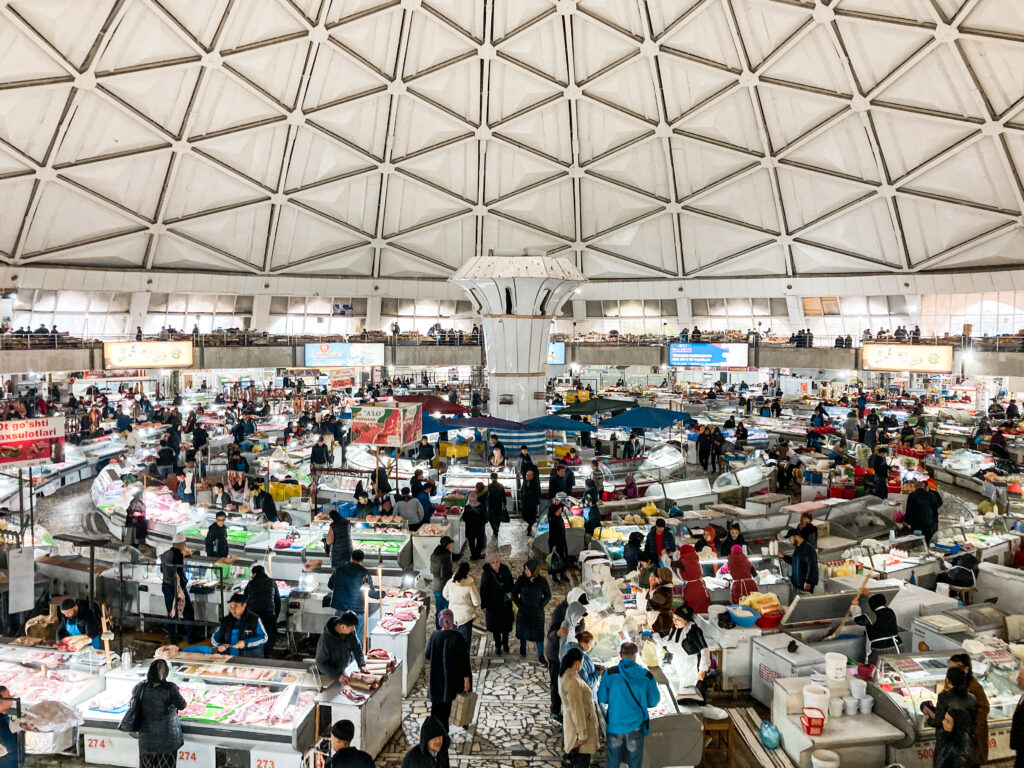
Admire Kukeldash Madrasa
Dating back to the 16th century, this is one of the oldest Islamic schools in Central Asia and a fine example of Timurid architecture. It’s located right near Chorsu Bazaar and is still in use today as a religious school.
Climb the Tashkent TV Tower
The Tashkent TV Tower is a prominent landmark in Uzbekistan’s capital, standing at 375 meters, making it the tallest structure in Central Asia. You can take the lift over to the 6th floor and enjoy the panoramic views of Tashkent and its surroundings. Additionally, the tower has a revolving dining venue that provides a unique culinary experience with changing vistas of the city.
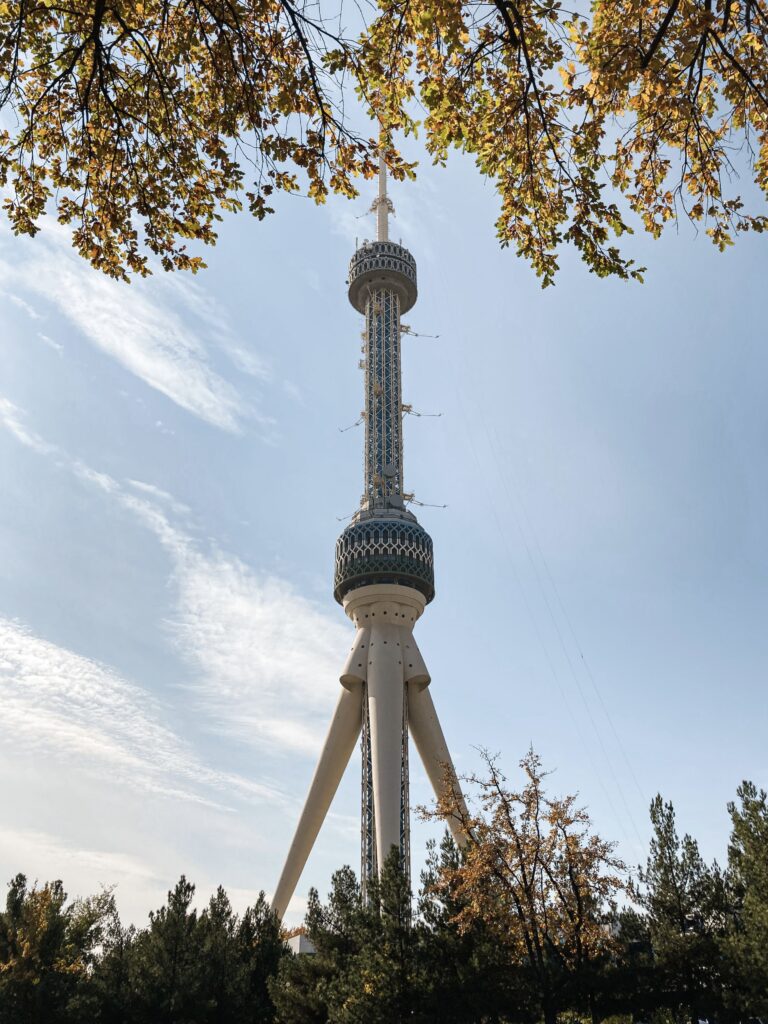
Memorial to the Victims of Repression and Surrounding Park
The Memorial to the Victims of Repression in Tashkent is a powerful and moving tribute to those who suffered during the Soviet era. Located near the TV Tower, this peaceful complex honours the memory of countless individuals who were imprisoned, exiled, or executed under political repression. The turquoise-domed rotunda, tranquil riverside park, and on-site museum provide a quiet space for reflection and offer a deeper insight into Uzbekistan’s turbulent past. I spent some time strolling around the complex and then relaxing by the river in the adjacent park.
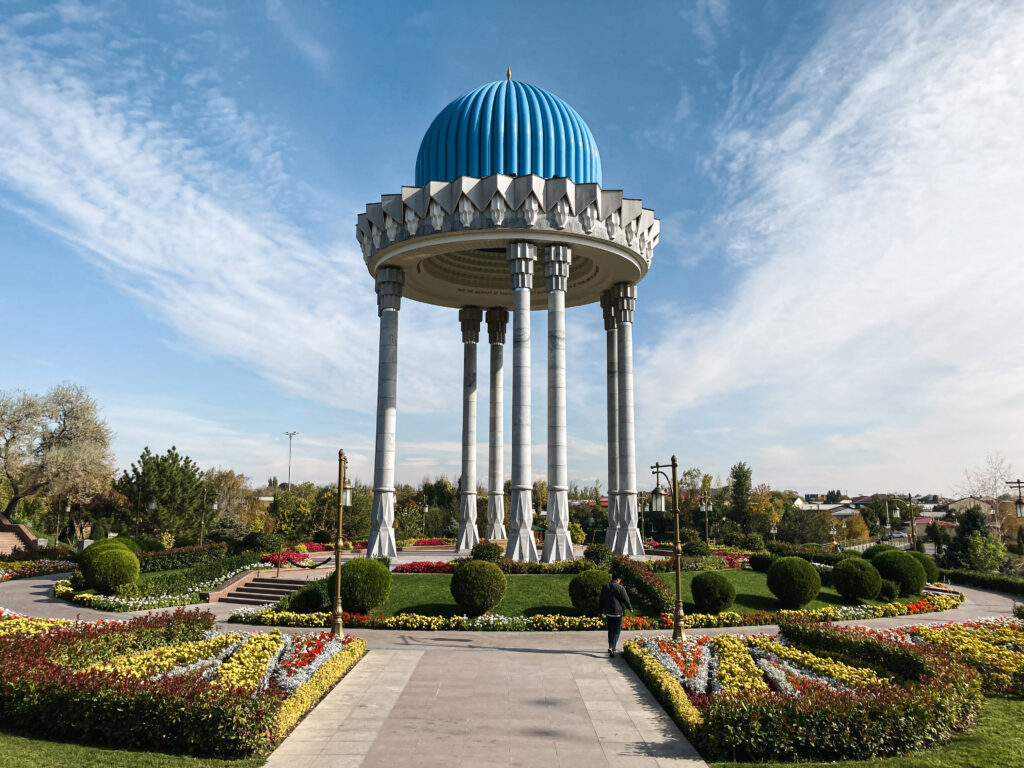 Memorial to the Victims of Repression and Park
Memorial to the Victims of Repression and Park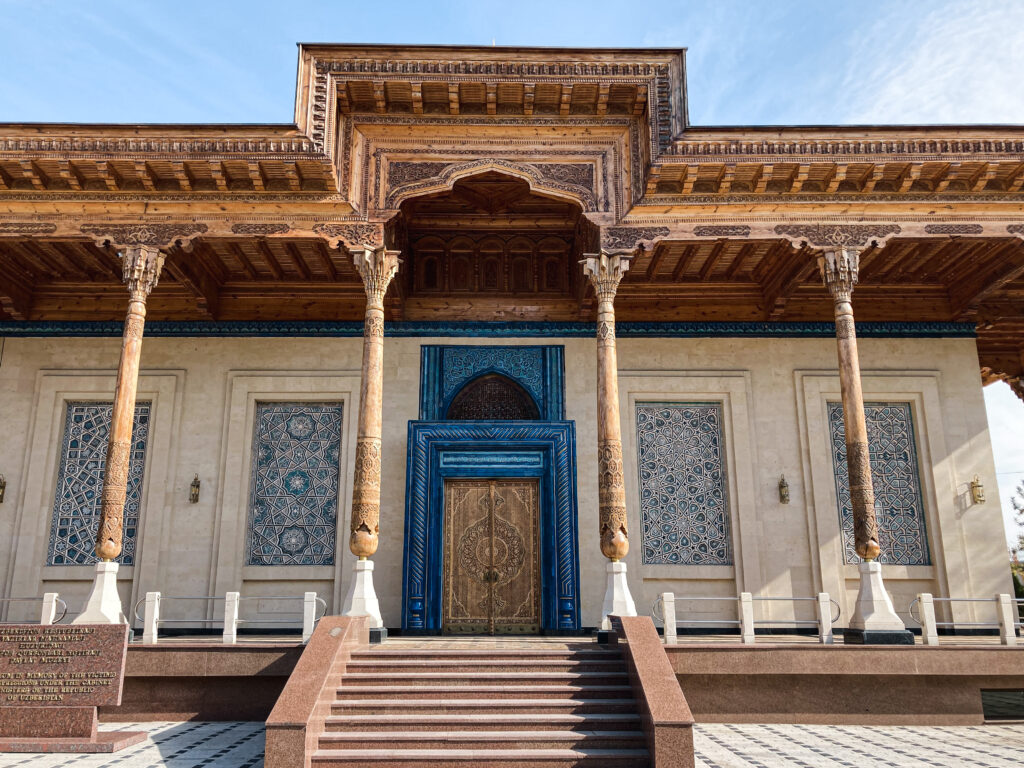 Museum to the Victims of Repression
Museum to the Victims of Repression
Explore the Soviet Side of Tashkent
Tashkent offers a fascinating glimpse into its Soviet past, with many architectural remnants and monuments that showcase the influence of the USSR on the city’s development. One of the best ways to explore the Soviet side of Tashkent is by visiting its grand, Soviet-era buildings and landmarks. Start by wandering through Independence Square, where you’ll find wide boulevards, large statues, and imposing government buildings that reflect the city’s Soviet legacy. The Tashkent Metro also boasts several stations with stunning Soviet-era designs, including intricate mosaics, chandeliers, and marble walls. Another must-see is the Uzbekistan Hotel, which is an example of Soviet-era luxury, with its grand exterior and modernist architecture.
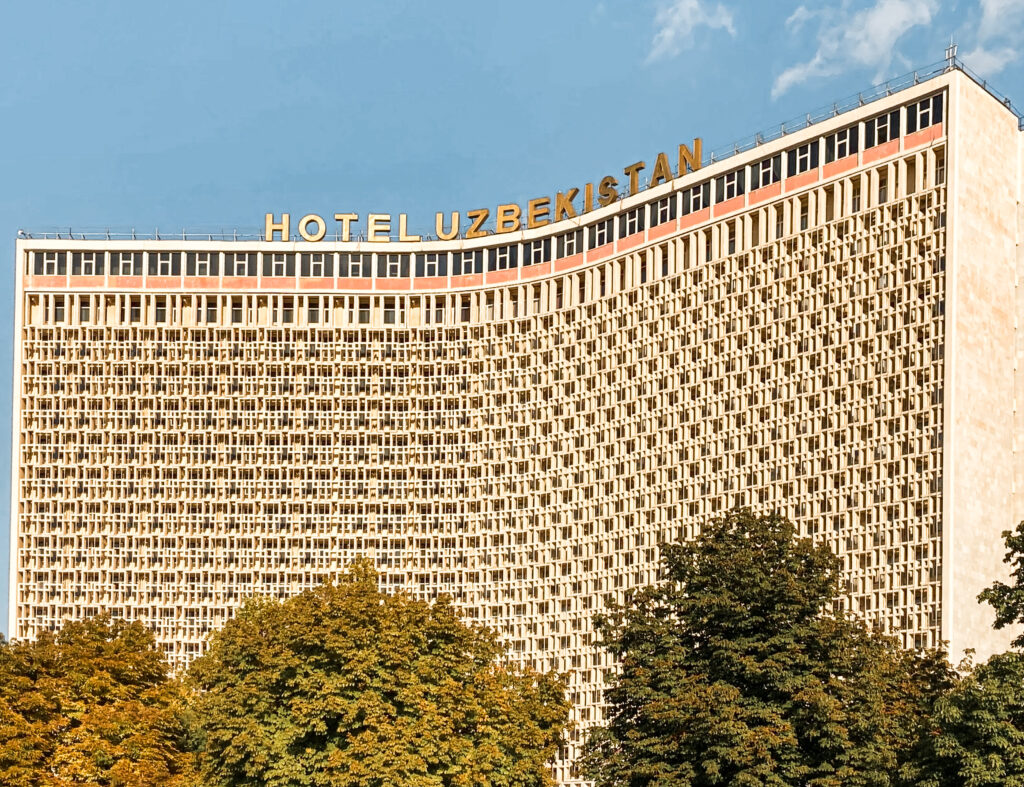 Hotel Uzbekistan
Hotel Uzbekistan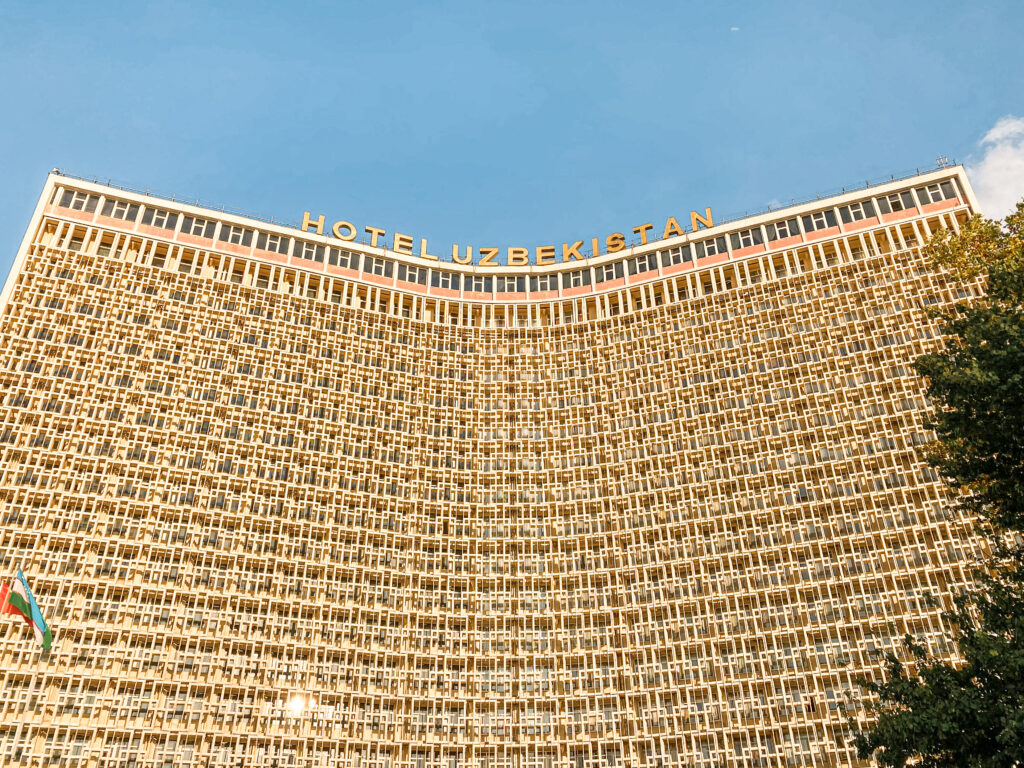 Hotel Uzbekistan
Hotel Uzbekistan
Where to Stay in Tashkent
Samarkand offers a wide range of accommodation options, catering to all budgets, and the number of choices continues to grow as Uzbekistan becomes an increasingly popular tourist destination. Whether you’re looking for budget-friendly hostels, mid-range hotels, or luxury stays, you’ll find something to suit your needs on the usual platforms like Booking.com. For the budget backpacker, try Art Hostel for its good location and good price but there are a few other hostels in the city.
Where to Eat in Tashkent
Besh Qozon
This is probably one of the most famous places to eat in Tashkent and you don’t want to miss it. Besh Qozon is located outside the the city centre (near Bodomzor metro station) but definitely worth the journey. It mainly serves Uzbekistan’s national dish – plov – which is prepared daily in crazy large quantities.
My advice would be to go before noon so you can witness the process of cooking hundreds of kg of rice right in front of you. The whole atmosphere is electric with men stirring a crazy amount of food in these giant pots and running around from one giant pot to another. Then you can take a sit at the dinning hall and order your much awaited plate of plov.
The plov served here is delicious (probably the best I’ve had) and it only costs around 30000 UZS (around $3) for a big plate of plov. Then you can add extras like horse meat sausage, quail eggs, etc for extra charge.
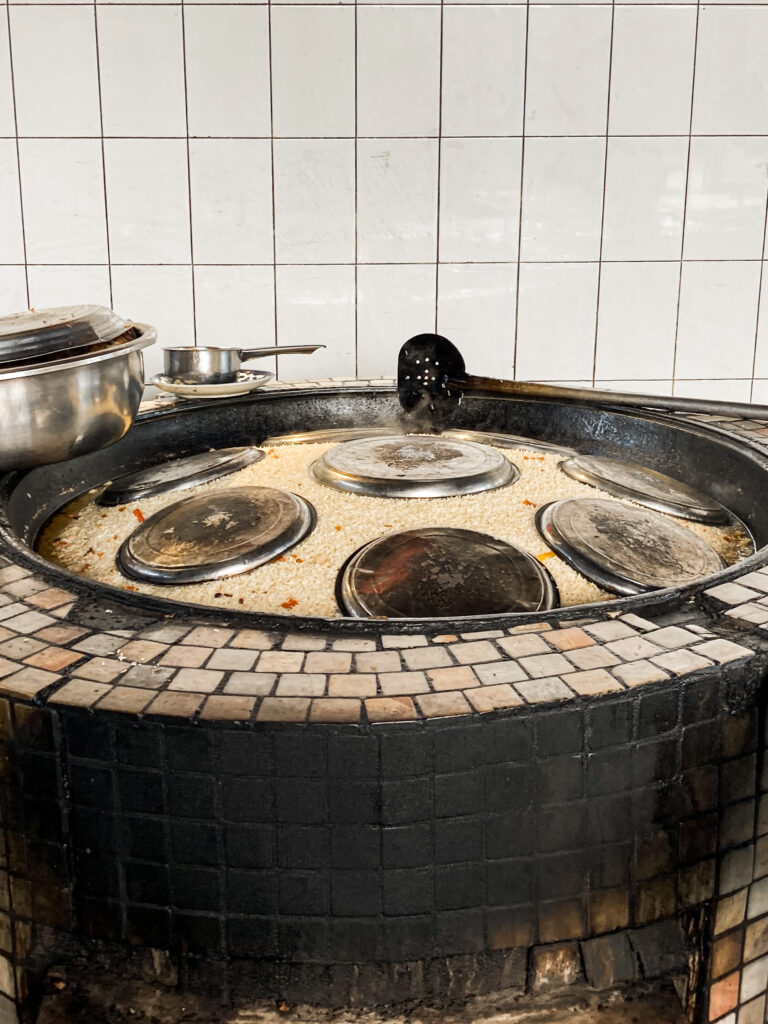 1st stage of Preparing the Rice for Plov
1st stage of Preparing the Rice for Plov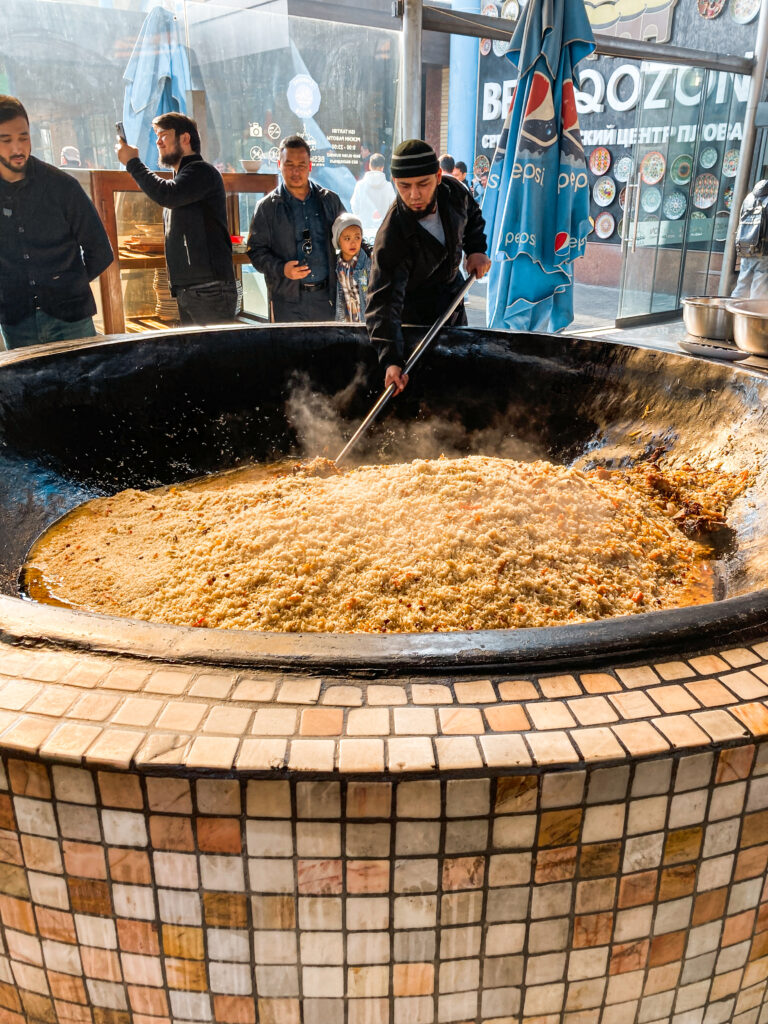 Stirring the Plov
Stirring the Plov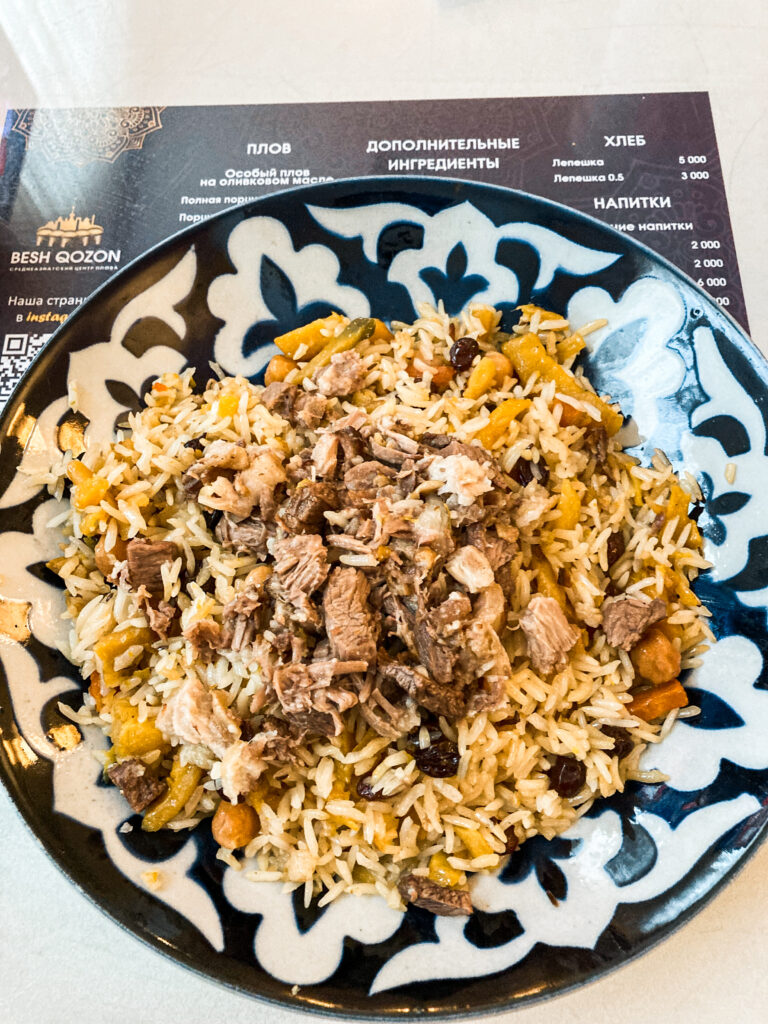 Final Plate of Plov
Final Plate of Plov
Other Places to Eat
Where to Go Next?
After exploring the capital city of Tashkent, now it’s time to continue your adventure into the Silk Road Cities. Check below for detailed budget travel guides to explore each city independently:
